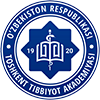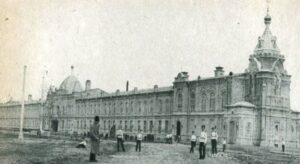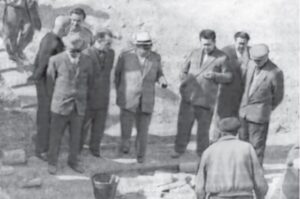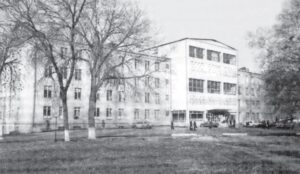ESTABLISHMENT OF MEDICAL FACULTY OF TURKESTAN STATE UNIVERSITY
The People’s Commissariat of Health was established as a part of the Council of People’s Commissars on July 11, 1918.The foundation of the Medicine of Turkestan was based on during that period. The People’s Commissariat of Health made several important decisions in the field of healthcare in the first years of its activity. One of them is the approval on March 13, 1919 of the Regulations on the management of medical institutions in the Republic of Turkestan. On April 13, 1919, a decision was made to organize a medical faculty as the part of the Turkestan State University. On September 17, 1919, at the first academic council of Turkestan State University, Professor P.P. Sitkovsky was appointed as a dean of the new medical faculty and K.G. Khrushyev as a deputy. 1919-1921 was the organizational period of the faculty, when its material and technical base were being created. During that period I.V. Davidovsky, A.N. Kryukov, P.P. Sitkovsky, V.F. Voyno-Yasenetskiy, K.G. Khrushyev, G.B. Berlatskiy had worked as the heads. S.N. Naumov, M.I. Prozin, G.G. Shcheglov, A.V. Miller, V.K. Arkadyev, I.P. Rojdestvensky, S.E. Zimmerman, A.A. Yudin, E.M. Shlyahtin, O.B. Lepeshinskaya, I.A. Smorodintsev, M.A. Zaharchenko, V.V. Vasilyevsky, M.S. Astrov, M.M. Nevyadomsky, G.S. Bom, G.A. Ilyin, N.I. Ragoza, A.N. Murzin, I.S. Milman, N.I. Osinovsky, F.I. Walker, S.A. Molchanov, G.N. Terehov and others were invited as teachers. On May 5, 1920 the Faculty of Medicine was provided with a cadet corps for accommodation and a hospital with 500 beds.
Cadet corps where the Institute was located (1920)
During that period 205 students studied at the 5 courses of the Faculty of Medicine. Five of them were representatives of the local population. In May 1921 the first 12 students graduated from the faculty and 27 students graduated in 1922. Among them there were representatives of the local population Z.I. Umidova and A. Dashanova. At first from the representatives of the local population T. Najmitdinov, M. Ismailov, A. Askarov, K. Usmanov, M. Mirsagatov, Yu. Ahmedjanov, H. Inayatov and Sh. Rahimov studied at the Faculty of Medicine. In subsequent years the faculty was headed by Professors K.G. Khrushyev (1921–1924) and M.I. Slonim (1924–1926). During that period the material and technical base of the faculty and teaching at clinical departments was improved significantly. In order to improve the quality and efficiency of education new teachers were invited including Professor N.I. Ragoza (Internal and Infectious Diseases), A.N. Murzin (Eye Diseases), I.S. Milman (Skin and Venereal Diseases), N.I. Osipovsky (Children Diseases), S.A. Molchanov (Radiology), G.N. Terehov (Pathological Anatomy), G.I. Ilyin (Operative Surgery), S.E. Zimmerman (Normal Anatomy), M.S. Astrov (Faculty Surgery), D.A. Vvedenskiy (Urology), and etc. 973 students studied at the Faculty of Medicine in 1923 most of whom (425) were girls. In a short period of time the material and technical base of the clinics was improved and new premises were created. In order to prepare highly qualified teaching staff the postgraduate studies were opened at the faculty. A great contribution to the development of the faculty was made by the deans of the faculty P.F. Borovsky (1926-1928), N.I. Ragoza (1928- 1929) and G.P. Fyodorov (1929-1931). In 1931 Medical Faculty was transformed into an independent Central Asian Medical Institute and G.P. Fyodorov was appointed its first director. By the end of that year he was transferred as a dean of the Medical Faculty and H.U. Umarov was appointed as director of the Institute. 177 teachers (25 professors, 26 assistant professors, 104 assistants) taught 1099 students in 1932. In 1932-1936 B. Sattarov was rector of the Institute. In 1935 Central Asian Medical Institute was renamed Tashkent Medical Institute (TMI). In its structure the Facultiy of Medical prophylactics and Sanitary Hygiene and The Faculty of Pediatrics and Dentistry started functioning. In 1937 1400 students studied at the Institute. The teachers personnel expanded from year to year as well as the number of the representatives of the local population who had graduated from the same Institute. It should be noted the names of the teachers such as Professors A.A. Akovbyan (Skin and Venereal Diseases), A.A. Askarov, E.I. Atahanov, G.A. Bussel (Therapy), G.L. Weinstein (Obstetrics and Gynecology), N.I. Ismailov (Therapy), S.A. Masumov (Surgery), A.S. Melik-Karamyan (Therapy), I.G. Gasparyan (Phthisiology), A.V. Georgievsky (Epidemiology), A.M. Geller (Surgery), I.A. Kassirsky, T.H. Najmitdinov (Tropical Diseases), N.N. Kompantsev (Pharmacology), M.F. Mirochnik, O.N. Pavlova, Z.I. Umidova (Therapy), B.A. Stekolnikov (Operative Surgery), K.G. Titov (Pediatrics), A.Yu. Yunusov (Normal Physiology), A.I. Magrupov (Pathological Anatomy). M.U. Mirsagatov was a rector of the Institute in 1938-1940. In 1940 B.I. Berliner and in 1941 R.I. Pulatov were appointed as rectors. By that time many new buildings of the Institute were built (experimental building, Clinics for Infectious Diseases, Oncology, Orthopedics), and the existing ones were repaired. In 1920 the number of the beds in the clinics of the Institute was 525 and by 1949 During that period 205 students studied at the 5 courses of the Faculty of Medicine. Five of them were representatives of the local population. In May 1921 the first 12 students graduated from the faculty and 27 students graduated in 1922. Among them there were representatives of the local population Z.I. Umidova and A. Dashanova. At first from the representatives of the local population T. Najmitdinov, M. Ismailov, A. Askarov, K. Usmanov, M. Mirsagatov, Yu. Ahmedjanov, H. Inayatov and Sh. Rahimov studied at the Faculty of Medicine. In subsequent years the faculty was headed by Professors K.G. Khrushyev (1921–1924) and M.I. Slonim (1924–1926). During that period the material and technical base of the faculty and teaching at clinical departments was improved significantly. In order to improve the quality and efficiency of education new teachers were invited including Professor N.I. Ragoza (Internal and Infectious Diseases), A.N. Murzin (Eye Diseases), I.S. Milman (Skin and Venereal Diseases), N.I. Osipovsky (Children Diseases), S.A. Molchanov (Radiology), G.N. Terehov (Pathological Anatomy), G.I. Ilyin (Operative Surgery), S.E. Zimmerman (Normal Anatomy), M.S. Astrov (Faculty Surgery), D.A. Vvedenskiy (Urology), and etc. 973 students studied at the Faculty of Medicine in 1923 most of whom (425) were girls. In a short period of time the material and technical base of the clinics was improved and new premises were created. In order to prepare highly qualified teaching staff the postgraduate studies were opened at the faculty. A great contribution to the development of the faculty was made by the deans of the faculty P.F. Borovsky (1926-1928), N.I. Ragoza (1928- 1929) and G.P. Fyodorov (1929-1931). In 1931 Medical Faculty was transformed into an independent Central Asian Medical Institute and G.P. Fyodorov was appointed its first director. By the end of that year he was transferred as a dean of the Medical Faculty and H.U. Umarov was appointed as director of the Institute. 177 teachers (25 professors, 26 assistant professors, 104 assistants) taught 1099 students in 1932. In 1932-1936 B. Sattarov was rector of the Institute. In 1935 Central Asian Medical Institute was renamed Tashkent Medical Institute (TMI). In its structure the Facultiy of Medical prophylactics and Sanitary Hygiene and The Faculty of Pediatrics and Dentistry started functioning. In 1937 1400 students studied at the Institute. The teachers personnel expanded from year to year as well as the number of the representatives of the local population who had graduated from the same Institute. It should be noted the names of the teachers such as Professors A.A. Akovbyan (Skin and Venereal Diseases), A.A. Askarov, E.I. Atahanov, G.A. Bussel (Therapy), G.L. Weinstein (Obstetrics and Gynecology), N.I. Ismailov (Therapy), S.A. Masumov (Surgery), A.S. Melik-Karamyan (Therapy), I.G. Gasparyan (Phthisiology), A.V. Georgievsky (Epidemiology), A.M. Geller (Surgery), I.A. Kassirsky, T.H. Najmitdinov (Tropical Diseases), N.N. Kompantsev (Pharmacology), M.F. Mirochnik, O.N. Pavlova, Z.I. Umidova (Therapy), B.A. Stekolnikov (Operative Surgery), K.G. Titov (Pediatrics), A.Yu. Yunusov (Normal Physiology), A.I. Magrupov (Pathological Anatomy). M.U. Mirsagatov was a rector of the Institute in 1938-1940. In 1940 B.I. Berliner and in 1941 R.I. Pulatov were appointed as rectors. By that time many new buildings of the Institute were built (experimental building, Clinics for Infectious Diseases, Oncology, Orthopedics), and the existing ones were repaired. In 1920 the number of the beds in the clinics of the Institute was 525 and by 1949 their number reached 1665. During that period 336 000 patients were treated in the clinics of the Institute. During the Second World War in 1941- 1945 more than 10 evacuation hospitals were opened on the territory of the Institute. Many professors and teachers went to the front including D.A. Vvedensky, L.D. Vasilenko, A.M. Geller, B.A. Stekolnikov and others. In 1944 Ya.K. Muminov was appointed as a rector of the institute. During the war years Tashkent State Medical Institute (TSMI) trained 2122 doctors 1630 of whom went to the war. There were M.A. Ashrapova, M. Muharramova, S.A. Fayziev, N.K. Ahmedov, M. Akmalov, U. Umarov, V.S. Karpuhina, L.I. Vaskovskaya, L.E. Sturgatskaya, S.A. Dolimov, F.F. Amirov, N.D. Mahsumov, N.A. Kambulin and others among them. In 1945 H.Z. Zahidov was appointed as a rector of the Institute. After the war the studies at the Institute were determined for 6 years. By that time the teaching staff had prepared new curricula. In 1947 Ya.H. Turakulov was appointed as a rector. Those years the Institute conducted research in 12 main areas of medicine. By 1950 there were 53 departments at TSMI where 40 professors, 72 associate professors, 206 assistants and 42 teachers worked. That time the number of published scientific papers reached 4167, journal articles 1268 and monographs 127. 339 scientific dissertations were defended at the Institute. In 1950 A.G. Gulamov was appointed as rector of the Institute and he headed it until 1965. During 1945-1953 the number of students increased from 2752 to 3158. In 1960 57 doctors of sciences, 18 honored scientists of the republic, 13 honored doctors of the republic, 2 corresponding members of the Academy of Sciences of Uzbekistan (A.A. Askarov, N.I. Ismailov) and 2 corresponding members of the Academy of Medical Sciences of the former USSR (Z.I. Umidova, E.I. Atahanov) worked at the Institute.
The ceremony of laying the first foundation stone of the Institute’s morphological building (1962)
In September 1965 Academician K.A. Zufarov was appointed as a rector of the Institute. By that time the material and technical base of the Institute had been expanded; a morphological building and a new building of the administration were put into operation on the territory of the Institute. The Central Research Laboratory was opened. By 1968 medical personnel began to be trained at subordinates and from 1969 through internships and clinical residences. The departments were equipped with modern teaching aids, inventory, and the library with new educational literature. Also research work intensified. In the 1970s more than 10 000 students studied at two Faculties of General Medicine, Pediatrics, Sanitation and Hygiene and Stomatology of the Institute. In 1971 Academician U.A. Aripov was appointed as a rector of the Institute who headed it till 1984. Taking into account that the half of the population of Uzbekistan was children in 1972 an independent Central Asian Pediatric Medical Institute was formed on the basis of the Pediatric Faculty of Tashkent State Medical Institute. Later on it was renamed Tashkent Pediatric Medical Institute. From 1962 the students from Asia, Africa and Latin America began to study at the Institute and by 1980 their number exceeded 170. That indicated an increase in the international prestige of the Institute. Since the founding of the Institute until 1970 the staff of the Institute had published more than 240 monographs and more than 10 thousand scientific articles. On October 25, 1971 by the decree of the Presidium of the Supreme Soviet of the USSR the Institute was awarded with the Order of the Red Banner of Labor for merits in the training of highly qualified doctors who contributed to the development of medical science in Uzbekistan. In connection with the increase in the number of students the Institute had to solve the issue of improving the material and technical base. To that purpose in 1972 the construction of a new complex of the Institute began in the Sabir Rahimov (at present Almazar) district of the city. During those years the main educational buildings, 10 dormitories for 5 000 people, a clinic of the Institute for 3 000 beds of the current Tashkent Medical Academy, 10 multi-story buildings for professors and teachers and about 40 cottages were built. In the 70s 847 employees worked at the Institute. There were 72 professors, 121 associate professors, 654 assistants among them. By the end of 1980, 1042 professors and teachers worked at 80 departments of the Institute including 6 academicians, 24 honored doctors of Uzbekistan, 90 doctors, and 552 candidates of medical sciences. Among the staff of the Institute there were heroes of socialist labor, laureates of the Lenin and State Prizes, the State Prize named after Beruny, and honored scientists. The scientists of the Institute published more than 17 000 scientific articles, 330 monographs, 57 textbooks and 215 collections. The hospital with 3 200 beds, several research Institutes, republican clinics, Tashkent city hospitals, maternity hospitals, dispensaries and centers for state sanitary and epidemiological surveillance of the Institute were attached to the Institute as the training bases for students. During that period educational, educational-methodical, scientific and medical work was improved and international relations were strengthened. The Institute established cooperation with leading medical institutions in Hungary, Germany, Poland, Turkey, England, the USA, Spain and Russia. In 1984 Professor O.S. Mahmudov was appointed as a rector. In 1987 Professor N.H. Shamirzaev was elected are rector of the Institute. During those years the students of the Institute began to be accepted to leading medical institutes in Russia and Ukraine. Taking into consideration the difficulties in managing a large Institute located on several educational bases the Cabinet of Ministers of the Republic of Uzbekistan decided to divide the Institute into two – the first and second Tashkent Medical Institute in 1990. Academician of the Academy of Sciences of Uzbekistan, Professor T.A. Daminov was appointed as a rector of the First Tashkent State Medical Institute. Professor H.Ya. Karimov was appointed as a rector of the Second Tashkent State Medical Institute. Initially there were two faculties at the First Tashkent State Medical Institute that is Medical and Stomatological. Also there were Medical and Sanitary Faculties at the Second Tashkent State Medical Institute. In March 1992 the branch of the First Tashkent State Medical Institute was opened in Urgench and Fergana branch of the Second Tashkent State Medical Institute was opened in Fergana. In 2005 Tashkent Medical Academy (TMA) was organized by the Decree of the President of the Republic of Uzbekistan I.A. Karimov № PD-3629 dated July 19, 2005 merging the First and Second Tashkent State Medical Institutes. Academician Sh.I. Karimov was appointed as the first rector of TMA. In 2014 in accordance with the Decree of the President of the Republic of Uzbekistan I.A. Karimov № PD-2215 dated July 22, 2014 the Faculty of Stomatology was separated into a separate Tashkent State Stomatology Institute. In 2018 Termez branch of Tashkent Medical Academy was opened in Termez.
Morphological corpus (1966)






